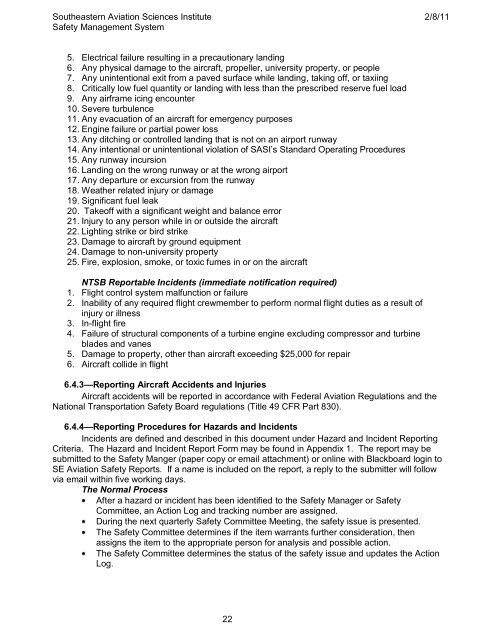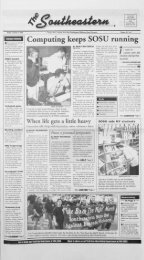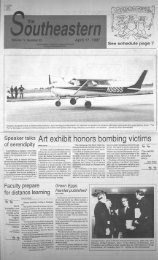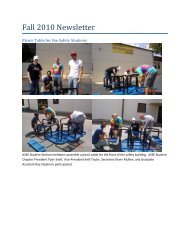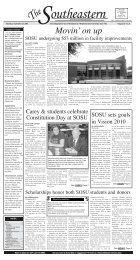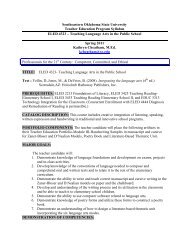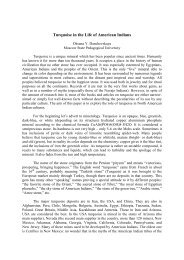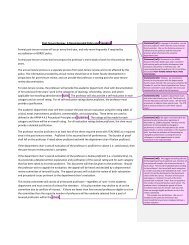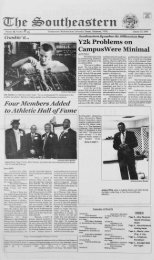Southeastern Aviation Safety Management System
Southeastern Aviation Safety Management System
Southeastern Aviation Safety Management System
Create successful ePaper yourself
Turn your PDF publications into a flip-book with our unique Google optimized e-Paper software.
<strong>Southeastern</strong> <strong>Aviation</strong> Sciences Institute 2/8/11<br />
<strong>Safety</strong> <strong>Management</strong> <strong>System</strong><br />
5. Electrical failure resulting in a precautionary landing<br />
6. Any physical damage to the aircraft, propeller, university property, or people<br />
7. Any unintentional exit from a paved surface while landing, taking off, or taxiing<br />
8. Critically low fuel quantity or landing with less than the prescribed reserve fuel load<br />
9. Any airframe icing encounter<br />
10. Severe turbulence<br />
11. Any evacuation of an aircraft for emergency purposes<br />
12. Engine failure or partial power loss<br />
13. Any ditching or controlled landing that is not on an airport runway<br />
14. Any intentional or unintentional violation of SASI’s Standard Operating Procedures<br />
15. Any runway incursion<br />
16. Landing on the wrong runway or at the wrong airport<br />
17. Any departure or excursion from the runway<br />
18. Weather related injury or damage<br />
19. Significant fuel leak<br />
20. Takeoff with a significant weight and balance error<br />
21. Injury to any person while in or outside the aircraft<br />
22. Lighting strike or bird strike<br />
23. Damage to aircraft by ground equipment<br />
24. Damage to non-university property<br />
25. Fire, explosion, smoke, or toxic fumes in or on the aircraft<br />
NTSB Reportable Incidents (immediate notification required)<br />
1. Flight control system malfunction or failure<br />
2. Inability of any required flight crewmember to perform normal flight duties as a result of<br />
injury or illness<br />
3. In-flight fire<br />
4. Failure of structural components of a turbine engine excluding compressor and turbine<br />
blades and vanes<br />
5. Damage to property, other than aircraft exceeding $25,000 for repair<br />
6. Aircraft collide in flight<br />
6.4.3—Reporting Aircraft Accidents and Injuries<br />
Aircraft accidents will be reported in accordance with Federal <strong>Aviation</strong> Regulations and the<br />
National Transportation <strong>Safety</strong> Board regulations (Title 49 CFR Part 830).<br />
6.4.4—Reporting Procedures for Hazards and Incidents<br />
Incidents are defined and described in this document under Hazard and Incident Reporting<br />
Criteria. The Hazard and Incident Report Form may be found in Appendix 1. The report may be<br />
submitted to the <strong>Safety</strong> Manger (paper copy or email attachment) or online with Blackboard login to<br />
SE <strong>Aviation</strong> <strong>Safety</strong> Reports. If a name is included on the report, a reply to the submitter will follow<br />
via email within five working days.<br />
The Normal Process<br />
After a hazard or incident has been identified to the <strong>Safety</strong> Manager or <strong>Safety</strong><br />
Committee, an Action Log and tracking number are assigned.<br />
During the next quarterly <strong>Safety</strong> Committee Meeting, the safety issue is presented.<br />
The <strong>Safety</strong> Committee determines if the item warrants further consideration, then<br />
assigns the item to the appropriate person for analysis and possible action.<br />
The <strong>Safety</strong> Committee determines the status of the safety issue and updates the Action<br />
Log.<br />
22


